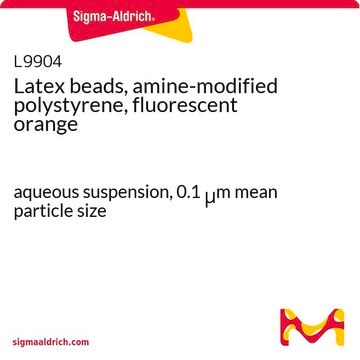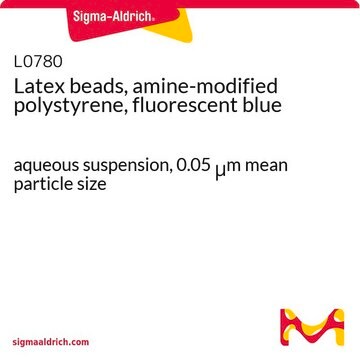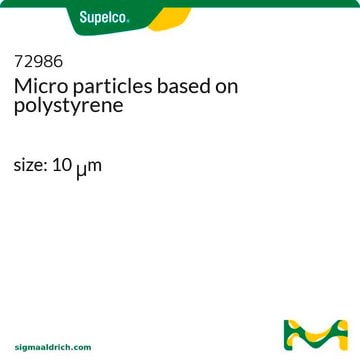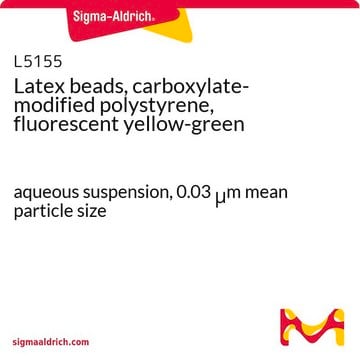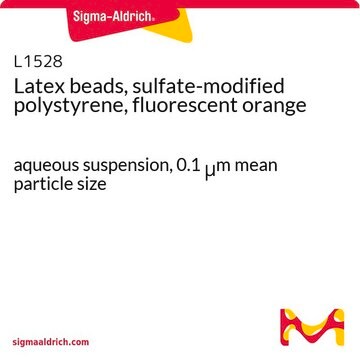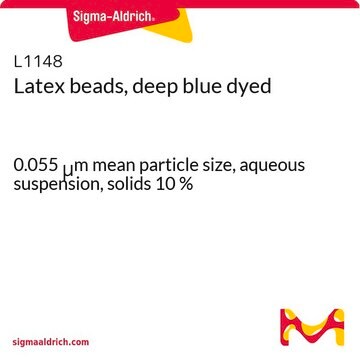These particles may be diluted using deionized water. Note that very dilute preparations may cause the particles to clump or flocculate. The additional of Triton X- 100, SDS, or TWEEN 20 at a range of 0.01-0.1% may be added to redisperse.
LB1
Latex beads, polystyrene
0.1 μm mean particle size
Sinónimos:
Latex Beads, Latex Microspheres
Seleccione un Tamaño
MXP 1,838.00
Fecha estimada de envío29 de marzo de 2025
Seleccione un Tamaño
About This Item
MXP 1,838.00
Fecha estimada de envío29 de marzo de 2025
Productos recomendados
form
aqueous suspension
composition
Solids, 10%
packaging
pack of 1 ea
mean particle size
0.1 μm
¿Está buscando productos similares? Visita Guía de comparación de productos
General description
Storage Class
10 - Combustible liquids
wgk_germany
WGK 3
flash_point_f
Not applicable
flash_point_c
Not applicable
Elija entre una de las versiones más recientes:
¿Ya tiene este producto?
Encuentre la documentación para los productos que ha comprado recientemente en la Biblioteca de documentos.
Los clientes también vieron
-
If I would like to dilute the concentration of this solution, what solvent can I dilute it with?
1 answer-
Helpful?
-
-
What is the composition/information on ingredients of the aqueous suspension?
1 answer-
As mentioned on the Datasheet associated with this product, the latex bead suspensions are composed mainly of polymer particles and water, with small amounts of surfactant, sodium bicarbonate, and potassium sulfate. A typical latex bead contains the following:
• Water >69.0%
• Polymer 30.0%
• Surfactant 0.1–0.5%
• Inorganic salts 0.2%
Please see the link below to review additional information provided in the product datasheet:
https://www.sigmaaldrich.com/deepweb/assets/sigmaaldrich/product/documents/348/819/lb1pis-ms.pdfHelpful?
-
-
what is the concentration of polystyrene microplastic [mg/ml] in this product No. LB1 .
1 answer-
This product is a 10% suspension of latex beads, meaning 10 grams per 100 mL. This is essentially 100 mg/mL.
Helpful?
-
-
Dear Sir/ mam how much quantity/ weight is available in 1mL.
1 answer-
This product is a 10% suspension of latex beads. The latex mass of the 10% concentration is 10g/100 mL or 100mg beads per 1 mL package.
Please see the link below to review the product datasheet:
https://www.sigmaaldrich.com/deepweb/assets/sigmaaldrich/product/documents/348/819/lb1pis-ms.pdfHelpful?
-
Active Filters
Nuestro equipo de científicos tiene experiencia en todas las áreas de investigación: Ciencias de la vida, Ciencia de los materiales, Síntesis química, Cromatografía, Analítica y muchas otras.
Póngase en contacto con el Servicio técnico
